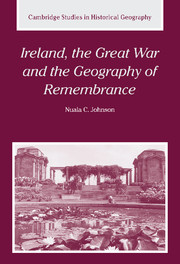Book contents
- Frontmatter
- Contents
- List of illustrations
- Acknowledgements
- 1 Geography, landscape and memory
- 2 A call to arms: recruitment poster and propaganda
- 3 Parading memory: peace day celebrations
- 4 Sculpting memory: space, memorials and rituals of remembrance
- 5 Scripting memory: literary landscapes and the war experience
- 6 Remembering the Easter Rebellion 1916
- 7 Conclusion
- Bibliography
- Index
- Cambridge Studies in Historical Geography
4 - Sculpting memory: space, memorials and rituals of remembrance
Published online by Cambridge University Press: 15 July 2009
- Frontmatter
- Contents
- List of illustrations
- Acknowledgements
- 1 Geography, landscape and memory
- 2 A call to arms: recruitment poster and propaganda
- 3 Parading memory: peace day celebrations
- 4 Sculpting memory: space, memorials and rituals of remembrance
- 5 Scripting memory: literary landscapes and the war experience
- 6 Remembering the Easter Rebellion 1916
- 7 Conclusion
- Bibliography
- Index
- Cambridge Studies in Historical Geography
Summary
Chapter 3 addressed the spectacle of remembrance at the Peace Day parades, yet the material basis of much commemorative energy focused on the construction of permanent spaces and artefacts of memory on both the war and Home Fronts. The mapping of the casualties of war through the making of memorial sites aroused widespread debate for the victorious and the defeated. It formed part of a larger on-going process in the redesign of public space through monumental architecture and statuary. War memorials thus exist in tandem with a suite of other markers, which map the cultural and historical identity of cities, regions and nation-states. Wagner-Pacifini and Schwartz suggest that ‘Memorial devices are not self-created; they are conceived and built by those who wish to bring to consciousness the events and people that others are inclined to forget.’ In particular, in post-war Ireland, the politics of remembrance and amnesia were interrelated in complex ways. With the establishment of the Irish Free State and the partition of the island, the use of public space to articulate a version of the past and a vision of the future was a highly disputed issue on both sides of the border. The claim that ‘Statues or monuments to the dead … owe their meaning to their intrinsic existence … [and] one could justify relocating them without altering their meaning’, is to ignore the historical moment and geographic specificity of debates undergirding the building of war memorials and to overemphasise their transcendental qualities.
- Type
- Chapter
- Information
- Ireland, the Great War and the Geography of Remembrance , pp. 80 - 111Publisher: Cambridge University PressPrint publication year: 2003



